February 2, 2022
If you hike in the Santa Monica Mountains, you may at some point notice alongside the trail a yellow sign reading: “Caution - Volunteer Trail Workers Ahead.” This may leave you wondering what dangers these volunteer workers pose to your safety and how to protect yourself from them. If you’re curious about them, where they come from, and how to become one, here is the scoop.
As part of my response to COVID isolation desperation, I decided to look up the Sierra Club’s weekend hikes and activities. The only activity that fit my schedule and preferred driving distance was a Saturday morning activity labeled “Trail Work” somewhere in the Santa Monica Mountains. With a shrug and a thought along the lines of “what-the-heck,” I decided to check it out. After signing up, I received a friendly email with clear driving directions to the trailhead and a list of what to bring. including hiking boots, sun protection, and work gloves.
That Saturday morning, it was dreary, foggy, and overcast as I drove up into the mountains on unfamiliar roads. But, after about 15 minutes, I was suddenly in dazzling sunshine, above the cloud cover, under blue skies. Down below me were the tops of clouds covering the valley like a down comforter.
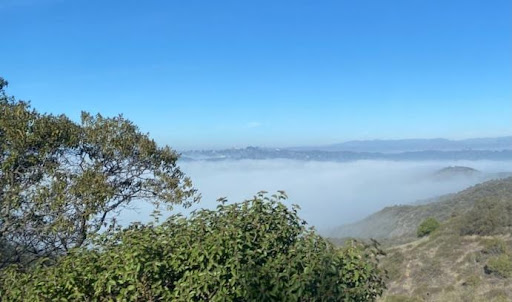
When I got to the trailhead, there were already a dozen cars and even more volunteers gathering and tying their boots. I was introduced to the email originator, Rachel Glegg, who turned out to be the Crew Leader. She guided me, along with two other newbies, through paperwork (releases and such) and a thorough safety orientation. The other crew members handed out tools, including pickaxes, saws, shears, and an interesting tool called a McLeod rake or rake hoe. This odd tool looks like a heavy rake with a two-sided blade — one with about six thick tines, the other a flat, sharpened hoe. I learned it was named for its creator, Malcolm McLeod, a US Forest Service ranger in the Sierras, and it’s used for fire fighting as well as trail restoration.
With a tool in each hand, we started out on the trail looking like either the Seven Dwarfs or a chain gang. When we reached an area where the trail had been overgrown, Rachel divided us up into pairs to work about 8 feet apart. The goal is to trim overgrowth to keep the trail clear 4 feet across and 8 feet vertically, except on equestrian trails where the vertical clearance needs to be 10 feet. Rachel explained that the reason crew members are stationed 8 feet apart is because we are swinging pick-axes overhead, and that, if we need to pass another worker, we must announce our presence and wait for a reply. For the same reason, she posted the yellow Caution signs at each end of our construction zone to alert passing hikers. Now you know that, should you happen upon one of those signs, the proper etiquette is to announce your presence and wait for acknowledgment from the trail workers before passing to avoid the inconvenience of a pickaxe in a body part.
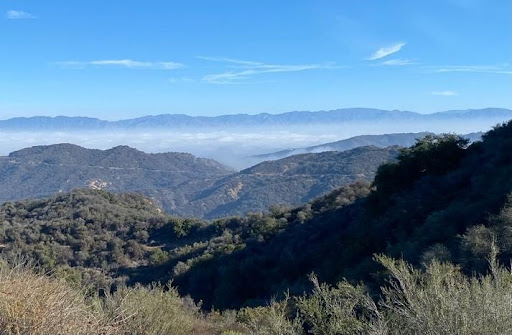
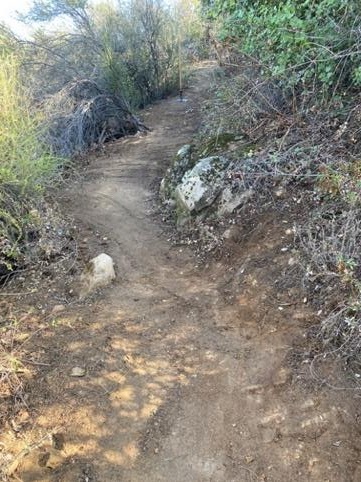
The trail grooming turned out to be meditative work, like gardening, but with a breathtaking view. It was a good antidote to home isolation: fresh air, a fun upper-body workout, a light dose of vitamin D, pleasant conversation, an elegant picnic with new friends, satisfying teamwork, and a sense of accomplishment.
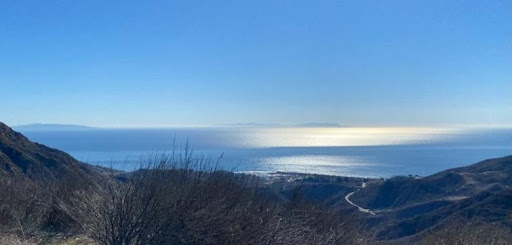
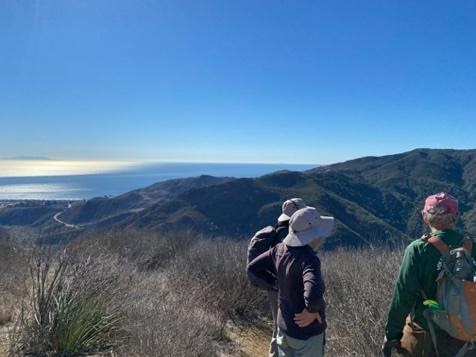
After about an hour or so, the crew leader called for a coffee break and gathered us in a shady spot with a view of the ocean to rest and share snacks. Then, and during lunch break, I had the chance to meet several interesting volunteers of all ages. I also had a chance to talk with another Crew Leader, Bill Vanderberg, who shared stories about the origins of this crew and its legendary members.
About 25 years ago, Bill had been hiking on trails for a long time and felt a desire to “give back.” He volunteered to work with conservationist Milt McAuley (for whom a peak is named in Malibu Creek State Park) in a group known as the Santa Monica Mountains Trails Council. This is where he learned about trail building. A few years later, he joined the Santa Monica Mountains Task Force (SMMTF), which had been created under the auspices of the Angeles Chapter of the Sierra Club about 40 years ago. The Task Force’s original purpose was to lobby for a National Park designation for the Santa Monica Mountains. Unfortunately, that goal was never realized, largely because ownership of the mountain lands was too fragmented. However, it was successful in having the mountains designated a National Recreational Area. Around that time, the Santa Monica Mountains Conservancy (SMMC) started buying property in these mountains to preserve it. The SMMC is the State of California “Joint Powers Agency,” which allows it to acquire land for the state. But, Bill explained, in order to purchase land with public funds, it was necessary to specify a “use.” Although many uses were possible, the least destructive was determined to be a system of trails. So, in about 1978, the SMM Task Force established a Trail Crew to start building a new system of trails in the Santa Monica Mountains.
An engineer named Ron Webster was the founder and a leader of the Trail Crew for over 40 years. Bill speaks about him with great reverence and mentioned that he had passed away only about a year ago. He said, “Ron was a master trail architect, a leader, and my mentor. He could look at a section of wildland and know exactly where the trail should go.” His first trail work was reestablishing the “Betty Rogers Trail” with permission of the State in Will Rogers State Historic Park in 1978. An 18-minute video Building the Garapito Trail provides a glimpse into the story behind the trail and the reasons why Ron was such a beloved leader. The hairstyles are from decades ago, but its depiction of a typical trail-work day is still accurate.
One of the many accomplishments of this group was the 67-mile-long Backbone Trail connecting Point Mugu State Park to the Will Rogers State Park along the ridge. This group was also largely or fully responsible, Bill explained, for preventing a number of major construction (or “destruction”) projects from taking place in the Santa Monica Mountains, including a Soka University campus intended for the King Gillette Ranch property. That land now serves as the headquarters for the National Recreation Area. This Task Force also prevailed in a one-year legal challenge from residents who opposed the revitalization of the Malibu Lagoon. In their latest legal challenge about three years ago, they sought to block the development of five mansions on land above Malibu. Despite being joined by conservation attorneys and residents of the area, the Task Force lost at the level of the trial court. Fortunately, through a technicality related to Los Angeles County having purview rather than the Coastal Commission, the Task Force won on appeal.
The SMM Task Force held its monthly meetings at the home of Jane Lewis, a member of its Executive Board and an active and, apparently beloved, member of the Trail Crew. Once she insisted on protecting a tree that was blocking the Garapito Trail, and the trail was detoured. It is still known as “Jane’s Tree.” At the top of one of the ridges near a fire road, Bill stopped to point out a solitary bench looking out over the Los Angeles basin. He said it’s called “Jane’s bench.”
About 10 years ago, there was no longer a need for new trails, and the SMM Task Force shifted its focus to trail maintenance. About 4-5 years ago, Crew Leader Rachel Glegg joined the team after she spent time studying with the California State Parks Trail Supervisor. Bill accepts credit for recruiting her from the Wilderness Training Class that he taught. He expresses enormous respect for her trail-building expertise and explains that she also transformed the team’s organization. Her tech-savvy outreach efforts doubled the number of volunteers and cut the average age in half.
In Bill’s experience, the crew has never had encounters with mountain lions or bobcats, probably because of their noise level. Occasionally deer would pass by and, once, a group of nude hikers. Their most frequent encounters have been with inexperienced hikers needing directions or water. He said the crew always carries an extra water supply, and dehydrated hikers are always grateful.
In the past few years, the crew has found that erosion and overgrowth leave enough ongoing trail damage to keep them busy. They have been heading into the hills each Saturday from 8:30-1:30, up until this January when the omicron surge finally forced cancellations for the past two Saturdays. So, in the absence of actual trail work, I resorted to virtual trail work instead – writing a story about it for the newsletter.
For anyone interested in spending a Saturday morning with the Sierra Club’s Angeles Chapter’s Santa Monica Mountains Volunteer Trail Workers, please check out the trail crew webpage: https://smmtf.org/trail-crew/